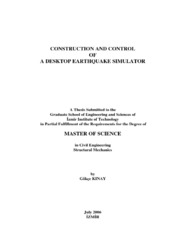Please use this identifier to cite or link to this item:
https://hdl.handle.net/11147/3429Full metadata record
| DC Field | Value | Language |
|---|---|---|
| dc.contributor.advisor | Turan, Gürsoy | - |
| dc.contributor.author | Kınay, Gökçe | - |
| dc.date.accessioned | 2014-07-22T13:51:31Z | - |
| dc.date.available | 2014-07-22T13:51:31Z | - |
| dc.date.issued | 2006 | - |
| dc.identifier.uri | http://hdl.handle.net/11147/3429 | - |
| dc.description | Thesis (Master)--Izmir Institute of Technology, Civil Engineering, Izmir, 2006 | en_US |
| dc.description | Includes bibliographical references (leaves: 52-56) | en_US |
| dc.description | Text in English; Abstract: Turkish and English | en_US |
| dc.description | x, 86 leaves | en_US |
| dc.description.abstract | A portable, servo motor driven, and single-degree-of freedom earthquake simulator is manufactured. The moving table has a dimension of 40 cm x 40 cm. It can carry a load of 80 kg, accelerated to 2 g (1 g @ 9.81 m/s 2 ). Its maximum displacement capacity is ± 7 cm. In order to obtain the desired motion, a voltage of .10 to +10 volts is applied to the servo unit (motor driver), which is adjusted to move the table at .25 cm/s and 25 cm/s, respectively. A runtime program is written to read an earthquake's velocity-time data and to produce an electrical voltage that takes care of the following two items: First, the maximum speed of the simulated earthquake can not be larger than the motor.s capacity. Second, the maximum earthquake displacement can not be larger than the table.s displacement capacity.In the present work, the recorded strong motion acceleration time series are processed in order to obtain useful data for engineering analysis. Strong motion accelerogram processing (earthquake data processing) is performed in Scilab. The objectives of strong motion data processing are corrections for the response of the strong motion instrument itself, and reduction of random noise in the recorded signals. The processing concentrates on the lowfrequency ranges of the usable signal in the records.The results obtained from comparison of the present work's outputs and some data providers' outputs are satisfactory. Some slight differences exist due to the different integration schemes and due to the application of different filter orders, zero-padding, and different filters for instance, acausal or causal Butterworth filter.The simulations are performed in a regular Linux environment and also in a Realtime Linux environment. The advantage of the realtime environment ensures the signals send to the servo driver to be on-time . no delay due to operating system tasks. | en_US |
| dc.language.iso | en | en_US |
| dc.publisher | Izmir Institute of Technology | en_US |
| dc.rights | info:eu-repo/semantics/openAccess | en_US |
| dc.subject.lcc | QE539.2.S37 .K67 2006 | en |
| dc.subject.lcsh | Seismic event location | en |
| dc.subject.lcsh | Earthquake simulators | en |
| dc.title | Construction and Control of a Desktop Earthquake Simulator | en_US |
| dc.type | Master Thesis | en_US |
| dc.institutionauthor | Kınay, Gökçe | - |
| dc.department | Thesis (Master)--İzmir Institute of Technology, Civil Engineering | en_US |
| dc.relation.publicationcategory | Tez | en_US |
| dc.identifier.wosquality | N/A | - |
| dc.identifier.scopusquality | N/A | - |
| item.openairecristype | http://purl.org/coar/resource_type/c_18cf | - |
| item.languageiso639-1 | en | - |
| item.openairetype | Master Thesis | - |
| item.grantfulltext | open | - |
| item.fulltext | With Fulltext | - |
| item.cerifentitytype | Publications | - |
| Appears in Collections: | Master Degree / Yüksek Lisans Tezleri Sürdürülebilir Yeşil Kampüs Koleksiyonu / Sustainable Green Campus Collection | |
Files in This Item:
| File | Description | Size | Format | |
|---|---|---|---|---|
| T000542.pdf | MasterThesis | 5.16 MB | Adobe PDF |  View/Open |
CORE Recommender
Page view(s)
302
checked on Mar 31, 2025
Download(s)
170
checked on Mar 31, 2025
Google ScholarTM
Check
Items in GCRIS Repository are protected by copyright, with all rights reserved, unless otherwise indicated.